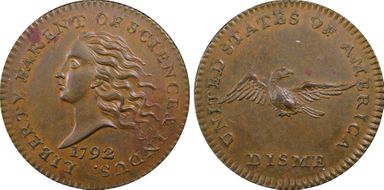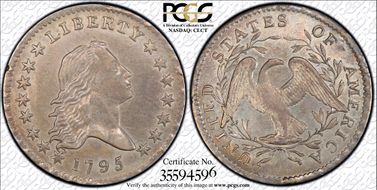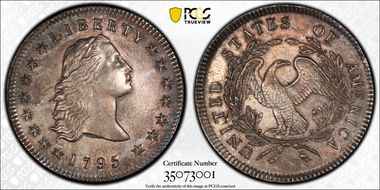cardinal 的钱币相册
With the R-6 copper pattern Disme of 1792, we see the direct influence of the famed Libertas Americana medal on the genesis of coinage designs for the new United States Mint. As the Senate and House of Representatives debated back and forth as to coinage designs to be mandated within the "Mint Act," or, more accurately, "An Act Establishing a Mint, and Regulating the Coins of the United States," the Senate was in favor of using the President's portait for circulating coinage. The House of Representatives, though, was steadfast in its resolve that coinage should bear an "image emblematic of Liberty." Ultimately, the Senate accepted the Representatives' resolution, and the Mint Act was signed into law on April 2, 1792. The copper Disme patterns were among the earliest patterns produced for the new coinage of the United States, and from there, the beautiful flowing hair design of the Libertas Americana Medal spread throughout the copper coinage of 1793 through 1797, and the silver coinage of 1794 and 1795.
With the R-6 copper pattern Disme of 1792, we see the direct influence of the famed Libertas Americana medal on the genesis of coinage designs for the new United States Mint. As the Senate and House of Representatives debated back and forth as to coinage designs to be mandated within the "Mint Act," or, more accurately, "An Act Establishing a Mint, and Regulating the Coins of the United States," the Senate was in favor of using the President's portait for circulating coinage. The House of Representatives, though, was steadfast in its resolve that coinage should bear an "image emblematic of Liberty." Ultimately, the Senate accepted the Representatives' resolution, and the Mint Act was signed into law on April 2, 1792. The copper Disme patterns were among the earliest patterns produced for the new coinage of the United States, and from there, the beautiful flowing hair design of the Libertas Americana Medal spread throughout the copper coinage of 1793 through 1797, and the silver coinage of 1794 and 1795.
The half dollars of 1794 and 1795 were large enough for an attractive artistic version of Miss Liberty. Indeed, as the small half dime design was more akin to the obverse of the Wreath Cent, the half dollar was much refined and certainly not "too unkempt." Alas, as with the half dime, however, Miss Liberty no longer has her Liberty Cap or pole.
Like the half dollars of 1794 and 1795, the dollars of 1794 and 1795 provided a canvas for artistic designs. While the dollars of 1794 were all struck from one set of dies, the flowing hair dollars of 1795 were struck in much larger quantities, using multiple dies with multiple nuances of their designs. Alas, as with the other silver denominations, Miss Liberty no longer has her Liberty Cap or pole.























